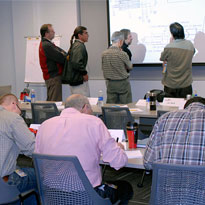LTE-A: Release 10, 11 & Beyond
- Course:LTE-A: Release 10, 11 & Beyond
- Course ID:LTE-A Duration:4-5 days Where: Your Office (7+ Persons)
- Download Course Description (PDF)
Available as a private, customized course for your group at your offices or ours and in some cases as a WebLive(TM) class.
Course Outline
Part 1: Requirements and Objectives
- Requirements
- ITU IMT Advanced Requirements
- LTE Advanced Requirements
- Spectrum Issues
- ITU Bands Identified for LTE Advanced
- Spectrum Planned for LTE Advanced in United States
- Spectrum Planned for LTE Advanced in Europe
- LTE Advanced Performance
- LTE Advanced Objectives and Milestones
- ITU Self Evaluation Results
- LTE Advanced Target and Achieved Performances
- Standardization Overview
- 1G to 4G
- LTE Release 10
- LTE Release 11 and Beyond
Part 2: New Developments in LTE Advanced
- Review of Release 8/9
- Release 8
- Release 9
- RAN Specific Features in LTE Advanced
- Network Specific Features in LTE-Advanced
Part 3: Carrier Aggregation in LTE Advanced
- Carrier Aggregation (CA) Concepts
- Benefits of CA
- Band Combinations
- Resource Allocation Options
- Hybrid-ARQ for CA
- Carrier Aggregation Types
- Intra-Band Carrier Aggregation
- Inter-Band Carrier Aggregation
- Contiguous Carrier Aggregation
- Non-Contiguous Carrier Aggregation
- Carrier Aggregation Classes
- Carrier Aggregation (CA) Operation
- RRC Configuration
- Primary and Secondary Carriers
- Cross Carrier Scheduling
- DL/UL Data Transfer
- Multi-carrier HARQ Feedback
Part 4: Coordination Multi-Point (CoMP) in LTE Advanced
- Coordinated MultiPoint (CoMP) Concepts
- Benefits of CoMP
- CoMP Sets
- CoMP Topologies
- CoMP Operations
- DL Joint Transmission
- DL Dynamic Point Selection with Muting
- CSI Processing
- UL Joint Reception
Part 5: Heterogeneous Networks (HetNet) and Small Cells in LTE Advanced
- Heterogeneous Networks (Hetnet) Cell Types
- Macrocells
- Small Cell Development
- Pico Cell
- Femto Cell (HeNB)
- Interference Management for HetNet (eICIC)
- ICIC in Rel. 8/9
- Enhancements in ICIC in Rel 10
- Other HetNet Developments
- HeNB Development in Rel 10
- Carrier Aggregation Enhancements in HetNet
- ICIC in Rel. 8/9
- Enhancements in ICIC in Rel 10
- Relays in HetNet Developments
- Overview
- Type 1 Relay
- Type 2 Relay
- Resource Partitioning for Relay-eNB link
- Access Backhaul Partitioning
- Backward Compatible Backhaul Partitioning and Resource Assignment
- R-Channel Design
Part 6: Other Enhancements in LTE Advanced Release 10
- Network Acquisition and Attach
- System Acquisition and Attach
- UE Capabilities
- Reference Signals
- DL/UL Traffic Operation
- Self-Organizing Networks (SON) CoMP Operations
- SON in Release 9
- SON Enhancement in Release 10
- DL MIMO Enhancements in Rel 10
- Coordinated and Distributed MIMO
- UL MIMO in Release 10
- Enhancements to System Latency
- Mobility Enhancements in LTE Advanced
- Cell Reselection and Handover
- DTX/DRX in LTE Advanced
- The Migration from LTE to LTE Advanced
- Interworking between LTE Advanced with 3GPP and non-3GPP Technologies
Part 7: LTE Advanced Beyond Release 10
- New Carrier Type
- 3D Beamforming
- 3D Channels
- Device-to-device Communications
- Machine Type Communications
- Positioning Enhancements
- Network Assisted Interference Coordination (NAIC)
Course Wrap-up: Recap and Discussion
Course in a Nutshell
This course provides a fundamental understanding of LTE Advanced, dubbed LTE-A for short. LTE Advanced was introduced in Release 10 to meet the requirements of the ITU IMT-Advanced, but its development extends into Releases 11, 12, and beyond.
The course offers an in-depth overview of features like Carrier Aggregation (CA), HetNets, and Coordinated Multipoint (CoMP). The signaling enhancements to session establishment and RRC connections are covered as well as the changes to mobility and power control procedures for LTE Advanced. Other LTE Advanced features such as the enhancements for Self-Organizing Networks (SONs) and MIMO techniques are also dealt with in depth in this course.
Customize It!
Let us know your reason for studying LTE-A so we can tailor the course to your specific needs. We can adapt the course to your interests including system design, details of the features set, system integration and testing, systems engineering, network engineering, or operations/support.
Also, depending on the participant background and required depth of knowledge, the course can be taught in four days or five.
Learn How To
- List the key LTE Advanced features and their advantages
- Describe the Carrier Aggregation fundamentals and advantages, including the air interface requirements to support Carrier Aggregation
- Explain the HetNet technology and its advantages
- Explain Coordinated Multipoint (CoMP) and key deployment topologies (UL and DL)
- Describe MIMO enhancements in LTE Advanced
Aimed At
This course is aimed at telecommunications operators, equipment and software developers, Defense and Home Land Security teams, and others who need to understand, plan for, work with, or deploy Release 10 or beyond LTE systems.
Prerequisites
Wireless communications basics, understanding of 2G/3G systems, and familiarity with at least the basics of LTE Releases 8 and 9.

